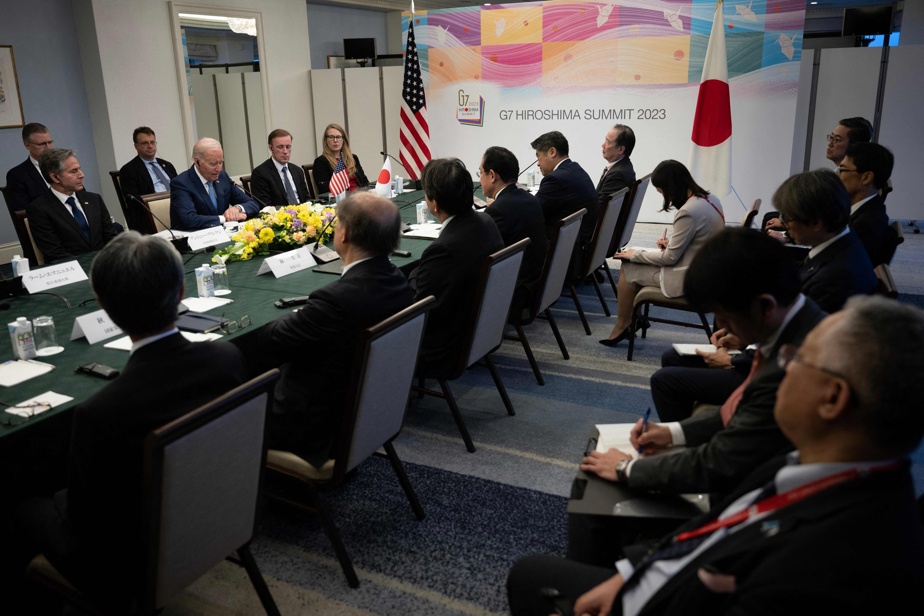(Hiroshima) The United States and its G7 allies announced new sanctions on Friday to stem Russia’s ability to continue its war in Ukraine, targeting the highly lucrative Russian diamond trade, just before the start of their summit in Hiroshima. .
In the city symbol of peace in Japan, the leaders of the main industrialized democracies must agree on a hardening vis-à-vis Russia and find a common line vis-à-vis the growing military and economic power of China.
Facing Moscow, the G7 should work to disrupt the country’s military supplies, close loopholes in sanctions-busting, further reduce its dependence on Russian energy and commit to freezing Moscow’s assets until the end of the war, assured a senior official of the American government of Joe Biden.
Washington opened the march on Friday by announcing “significant” new sanctions against the “Russian war machine”.
They must prevent “about 70 entities in Russia and other countries from receiving American exported goods,” the official added.
Other members of the G7 — which includes the United States, Japan, Germany, France, the United Kingdom, Italy and Canada — followed, with London soon after unveiling new measures targeting the Russian mining sector, including an embargo on the trade of diamonds, which every year brings several billion dollars to Moscow.
These sanctions show that “the G7 remains united in the face of the threat from Russia and firm in its support for Ukraine”, declared British Prime Minister Rishi Sunak.
“Russian diamonds are not forever,” quipped the President of the European Council Charles Michel, announcing that the European Union would also limit trade.
Suspense around Zelensky
The United Arab Emirates, India and Belgium, which is a member of the EU, are among the main importers of Russian diamonds, and an EU official said on Thursday that New Delhi’s membership would be crucial.
G7 leaders will be able to present their case directly to Indian Prime Minister Narendra Modi, whose country has close military ties with Russia, and who has refused to condemn the Russian invasion of Ukraine.
India is one of the eight third countries whose leaders were invited to Hiroshima: a way for the G7 to try to rally certain states reluctant to condemn Moscow and oppose Beijing’s growing military ambitions.
Ukrainian President Volodymyr Zelensky is expected to speak via video conference over the weekend. The Japanese government has ruled out the possibility of his coming in person, but speculation persists.
Before starting their discussions, the leaders of the G7 met on Friday morning at the Hiroshima Peace Memorial Park.
Heads of state and government were to lay wreaths at the cenotaph which commemorates the approximately 140,000 people killed by the US atomic bomb on August 6, 1945.
Japanese dream of disarmament
“I hope that here in Hiroshima, the G7 and the leaders of other countries will show their commitment to peace, which history will remember,” said Japanese Prime Minister Fumio Kishida on Thursday, who has his family and political roots in Hiroshima and who would like to put nuclear disarmament on the agenda.
This moment of contemplation should however remain symbolic given that the United States, the United Kingdom and France possess thousands of nuclear warheads, and that the other members of the G7, including Japan, are covered by the “nuclear umbrella American.
Mr Biden will become only the second sitting US president to visit Hiroshima, but like Barack Obama in 2016 he is not expected to apologize to Japan.
Besides Ukraine, the agenda will also be dominated by China and the diversification of the supply chains of the G7 countries to guard against the risk of “economic coercion” from Beijing.
“We want to organize global supply, trade and investment relationships in such a way that risks are not increased by dependence on certain countries,” Chancellor Olaf said on Thursday. Scholz, without citing China.
France, however, assured that it would be “not a G7 of confrontation” but “a G7 of cooperation and the requirement with regard to China”.
